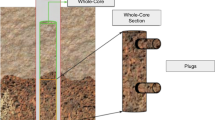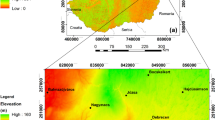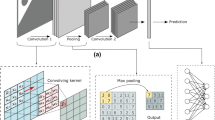Abstract
Dissolution is a common diagenetic effect in carbonate formations. Vugs caused by dissolution significantly impact carbonate reservoir quality by affecting the porosity and permeability of the reservoir. However, without core and image logs, the identification and classification of vugs using wireline logs only is challenging, because logging tool responses reflect a mixed effect of changing mineral/fluid composition and diagenetic features. This paper presents a data-driven approach using neural networks to identify vugs and classify vug facies based on vug size. The purpose is to predict wells/intervals with limited measurements by machine learning models trained with core data from key wells. The input features for vug identification are conventional well logs (i.e., gamma ray, resistivity, neutron/density porosity, photoelectric factor, and acoustic slowness) from the Cambrian-Ordovician Arbuckle formation, Kansas. Two classification labels are used as the prediction target for the neural networks: (1) a binary vuggy index derived from nuclear magnetic resonance (NMR) measurements using a cutoff on T2 distribution, which presents the proportion of large pores over the total porosity, and (2) vug size labels from depth-by-depth core visual descriptions. A one-hidden-layer shallow neural network is compared against deep neural networks, including structures such as one-dimensional convolutional layers (1-D CNN) and long short-term memory (LSTM) layers. Results suggest that using a combination of multi-mineral analysis results and original well logs will increase the prediction accuracy of vug facies. Shallow and deep neural networks show a similar ability to identify vugs, with average accuracy of around 80%. However, to predict vug-size-based facies labels, deep neural networks outperform shallow neural networks, with overall accuracy improved by as much as 10%. The proposed method shows that deep neural networks (1-D CNN and LSTM) are reliable tools for vug facies prediction.

















Similar content being viewed by others
References
Bednarik RG (2019) Rock metamorphosis by kinetic energy. Emerg Sci J 3(5):293–302. https://doi.org/10.28991/esj-2019-01192
Bishop CM (2006) Pattern recognition and machine learning. Springer, Berlin
Bize-Forest N, Lima L, Baines V, Boyd A, Abbots F, Barnett A (2018) Using machine-learning for depositional facies prediction in a complex carbonate reservoir. In: SPWLA 59th annual logging symposium. Society of Petrophysicists and Well-Log Analysts
Brazell S, Bayeh A, Ashby M, Burton D (2019) A machine-learning-based approach to assistive well-log correlation. Petrophysics 60(04):469–479. https://doi.org/10.30632/pjv60n4-2019a1
Brie A, Johnson DL, Nurmi RD (1985) Effect of spherical pores on sonic and resistivity measurements. In: SPWLA 26th annual logging symposium. Society of Petrophysicists and Well-Log Analysts
Clerke EA, Allen DF, Crary SC, Srivastava A, Ramamoorthy R, Saldungaray P, Savundararaj P, Heliot D, Goswami J, Bordakov G (2014) Wireline spectral porosity analysis of the Arab Limestone—From Rosetta Stone to CIPHER. In: SPWLA 55th annual logging symposium. Society of Petrophysicists and Well-Log Analysts
Cracknell MJ, Reading AM (2014) Geological mapping using remote sensing data: a comparison of five machine learning algorithms, their response to variations in the spatial distribution of training data and the use of explicit spatial information. Comput Geosci 63:22–33. https://doi.org/10.1016/j.cageo.2013.10.008
Deng T, Xu C, Jobe D, Xu R (2019) A comparative study of three supervised machine-learning algorithms for classifying carbonate vuggy facies in the Kansas Arbuckle Formation. Petrophysics 60(6):838–853. https://doi.org/10.30632/pjv60n6-2019a8
Doveton J, Watney L (2014) Textural and pore size analysis of carbonates from integrated core and nuclear magnetic resonance logging: an Arbuckle study. Interpretation 3(1):SA77–SA89. https://doi.org/10.1190/INT-2014-0050.1
Franseen EK, Byrnes AP, Cansler JR, Carr T (2004) The geology of Kansas: Arbuckle group. Kansas Geological Survey
Ghorbani S, Barari M, Hosseini M (2017) A modern method to improve of detecting and categorizing mechanism for micro seismic events data using boost learning system. Civ Eng J 3(9):715–726. https://doi.org/10.21859/cej-03098
Glorot X, Bordes A, Bengio Y (2011) Deep sparse rectifier neural networks. In: Proceedings of the fourteenth international conference on artificial intelligence and statistics, pp 315–323
Halotel J, Demyanov V, Gardiner A (2019) Value of geologically derived features in machine learning facies classification. Math Geosci. https://doi.org/10.1007/s11004-019-09838-0
Hastie T, Tibshirani R, Friedman J (2009) The elements of statistical learning: data mining, inference, and prediction. Springer, New York
Imamverdiyev Y, Sukhostat L (2019) Lithological facies classification using deep convolutional neural network. J Petrol Sci Eng 174:216–228. https://doi.org/10.1016/j.petrol.2018.11.023
Jobe TD, Vital-Brazil E, Khaif M (2018) Geological feature prediction using image-based machine learning. Petrophysics 59(06):750–760. https://doi.org/10.30632/pjv59n6-2018a1
Kingma DP, Ba J (2014) Adam: a method for stochastic optimization. arXiv preprint arXiv:1412.6980
Lacassie JP, Del Solar JR, Roser B, Hervé F (2006) Visualization of volcanic rock geochemical data and classification with artificial neural networks. Math Geol 38(6):697–710. https://doi.org/10.1007/s11004-006-9042-z
LeCun Y, Bengio Y, Hinton G (2015) Deep learning. Nature 521(7553):436–444. https://doi.org/10.1038/nature14539
Lucia FJ (2007) Carbonate reservoir characterization: an integrated approach. Springer, Berlin. https://doi.org/10.1007/978-3-662-03985-4
Ma YZ (2011) Lithofacies clustering using principal component analysis and neural network: applications to wireline logs. Math Geosci 43(4):401–419. https://doi.org/10.1007/s11004-011-9335-8
Mohammadi J, Ataei M, Kakaei RK, Mikaeil R, Haghshenas SS (2018) Prediction of the production rate of chain saw machine using the multilayer perceptron (MLP) neural network. Civ Eng J 4(7):1575–1583. https://doi.org/10.28991/cej-0309196
Newberry BM, Grace LM, Stief DO (1996) Analysis of carbonate dual porosity systems from borehole electrical images. In: Permian basin oil and gas recovery conference. Society of Petroleum Engineers. https://doi.org/10.2118/35158-ms
Perez-Rosales C, Mercado-Diaz A, Cruz-Hernandez J, Islas-Juarez R (2002) Electric resistivity of vuggy fractured media. In: SPE international petroleum conference and exhibition in Mexico. Society of Petroleum Engineers. https://doi.org/10.2118/74340-ms
Rolon L, Mohaghegh SD, Ameri S, Gaskari R, McDaniel B (2009) Using artificial neural networks to generate synthetic well logs. J Nat Gas Sci Eng 1(4–5):118–133. https://doi.org/10.1016/j.jngse.2009.08.003
Sak H, Senior A, Beaufays F (2014) Long short-term memory based recurrent neural network architectures for large vocabulary speech recognition. arXiv preprint arXiv:1402.1128
Tang H, Meddaugh WS, Toomey N (2011) Using an artificial-neural-network method to predict carbonate well log facies successfully. SPE Reserv Eval Eng 14(01):35–44
Tschannen V, Delescluse M, Rodriguez M, Keuper J (2017) Facies classification from well logs using an inception convolutional network. arXiv preprint arXiv:1706.00613
Wang G, Carr TR (2012) Marcellus shale lithofacies prediction by multiclass neural network classification in the Appalachian Basin. Math Geosci 44(8):975–1004. https://doi.org/10.1007/s11004-012-9421-6
Xu C, Misra S, Srinivasan P, Ma S (2019) When petrophysics meets big data: what can machine do? Society of Petroleum Engineers. SPE Middle East Oil and Gas Show and Conference, 18–21 March, Manama, Bahrain. https://doi.org/10.2118/195068-ms
Xu R, Deng T, Jiang J, Jobe D, Xu C (2020) Integration of NMR and conventional logs for vuggy facies classification in the Arbuckle Formation: a machine learning approach. SPE Reserv Eval Eng. https://doi.org/10.2118/201102-pa
Zhu L, Li H, Yang Z, Li C, Ao Y (2018) Intelligent logging lithological interpretation with convolution neural networks. Petrophysics 59(6):799–810. https://doi.org/10.30632/pjv59n6-2018a5
Acknowledgments
The authors want to thank the Kansas Geological Survey for providing the dataset to test the algorithms and workflow. A special note of thanks goes to Dr. Weichang Li for his constructive feedback in machine learning algorithms selection and development.
Author information
Authors and Affiliations
Corresponding author
Rights and permissions
About this article
Cite this article
Deng, T., Xu, C., Lang, X. et al. Diagenetic Facies Classification in the Arbuckle Formation Using Deep Neural Networks. Math Geosci 53, 1491–1512 (2021). https://doi.org/10.1007/s11004-021-09918-0
Received:
Accepted:
Published:
Issue Date:
DOI: https://doi.org/10.1007/s11004-021-09918-0




